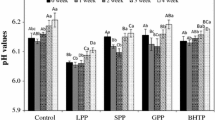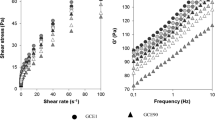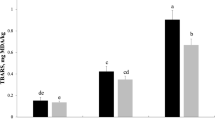Abstract
Ginger powder effects were evaluated in cooked pork burgers after a refrigerated storage as raw meat products at 4 °C up to 7 days. Physical–chemical characteristics, fatty acids profile, lipid oxidation and antioxidant capacity of burgers were tested in control samples (only meat, C) and in two formulations containing 1% and 2% of ginger powder (G1 and G2). Ginger naturally brought yellow pigments that increased b* index of G2 burgers. Colour variations between C and G2 were also visible by human eyes as showed by ΔE indices. Ginger improved PUFAω3 and PUFAω6 percentages to the detriment of SFA with following decreases of atherogenicity and thrombogenicity indices. Antioxidants present in ginger powder reduced lipid oxidation (TBARS) and increased antioxidant capacity (FRAP, ABTS and DPPH) of burgers. Results highlighted that ginger powder could express increasing the antioxidant capacity and reducing lipid oxidation of burgers with the final income of healthier products than the control ones.

Similar content being viewed by others
References
Emswiler BS, Pierson CJ, Kotula AW (1976) Bacteriological quality and shelf life of ground beef. Appl Environ Microbiol 31:826–830
Mancini R, Hunt M (2005) Current research in meat color. Meat Sci 71:100–121. https://doi.org/10.1016/j.meatsci.2005.03.003
Hygreeva D, Pandey MC (2016) Novel approaches in improving the quality and safety aspects of processed meat products through high pressure processing technology—a review. Trends Food Sci Technol 54:175–185. https://doi.org/10.1016/j.tifs.2016.06.002
Jiang J, Xiong YL (2016) Natural antioxidants as food and feed additives to promote health benefits and quality of meat products: a review. Meat Sci 120:107–117. https://doi.org/10.1016/j.meatsci.2016.04.005
Shahidi F, Zhong Y (2010) Novel antioxidants in food quality preservation and health promotion. Eur J Lipid Sci Technol 112:930–940. https://doi.org/10.1002/ejlt.201000044
Naveena M, Sen AR, Vaithiyanathan S, Babji Y, Kondaiah N (2008) Comparative efficacy of pomegranate juice, pomegranate rind powder extract and BHT as antioxidants in cooked chicken patties. Meat Sci 80:1304–1308
Sebranek JG, Sewalt VJH, Robbins KL, Houser T (2005) Comparison of a natural rosemary extract and BHA/BHT for relative antioxidant effectiveness in pork sausage. Meat Sci 69:289–296. https://doi.org/10.1016/j.meatsci.2004.07.010
Falowo AB, Fayemi PO, Muchenje V (2014) Natural antioxidants against lipid–protein oxidative deterioration in meat and meat products: a review. Food Res Int 64:171–181. https://doi.org/10.1016/j.foodres.2014.06.022
Shahidi F, Ambigaipalan P (2015) Phenolics and polyphenolics in foods, beverages and spices: Antioxidant activity and health effects—a review. J Funct Foods 18:820–897. https://doi.org/10.1016/j.jff.2015.06.018
Shah MA, Bosco SJD, Mir SA (2014) Plant extracts as natural antioxidants in meat and meat products. Meat Sci 98:21–33. https://doi.org/10.1016/j.meatsci.2014.03.020
Abdel-Naeem HHS, Mohamed HMH (2016) Improving the physico-chemical and sensory characteristics of camel meat burger patties using ginger extract and papain. Meat Sci 118:52–60. https://doi.org/10.1016/j.meatsci.2016.03.021
Cao Y, Gu W, Zhang J, Chu Y, Ye X, Hu Y, Chen J (2013) Effects of chitosan, aqueous extract of ginger, onion and garlic on quality and shelf life of stewed-pork during refrigerated storage. Food Chem 141:1655–1660. https://doi.org/10.1016/j.foodchem.2013.04.084
Mancini S, Preziuso G, Dal Bosco A, Roscini V, Parisi G, Paci G (2017) Modifications of fatty acids profile, lipid peroxidation and antioxidant capacity in raw and cooked rabbit burgers added with ginger. Meat Sci 133:151–158. https://doi.org/10.1016/j.meatsci.2017.07.003
Mancini S, Preziuso G, Fratini F, Torracca B, Nuvoloni R, Dal Bosco A, Paci G (2017) Qualitative improvement of rabbit burgers using Zingiber officinale Roscoe powder. World Rabbit Sci 25:367. https://doi.org/10.4995/wrs.2017.7656
Zachariah TJ (2008) Ginger. In: Parthasarathy VA, Chempakam B, Zachriah TJ (eds) Chemistry of spices. CABI, London, pp 70–96
Kikuzaki H, Nakatani N (1993) Antioxidant effects of some ginger constituents. J Food Sci 58:1407–1410. https://doi.org/10.1111/j.1365-2621.1993.tb06194.x
Rahmani AH, Al Shabrmi FM, Aly SM (2014) Active ingredients of ginger as potential candidates in the prevention and treatment of diseases via modulation of biological activities. Int J Physiol Pathophysiol Pharmacol 6:125–136
Ghasemzadeh A, Jaafar HZ, Rahmat A (2015) Optimization protocol for the extraction of 6-gingerol and 6-shogaol from Zingiber officinale var. Rubrum theilade and improving antioxidant and anticancer activity using response surface methodology. BMC Complement Altern Med 15:258
Yeh H, Chuang C, Chen H, Wan C, Chen T, Lin L (2014) Bioactive components analysis of two various gingers (Zingiber officinale Roscoe) and antioxidant effect of ginger extracts. LWT Food Sci Technol 55:329–334. https://doi.org/10.1016/j.lwt.2013.08.003
Shukla Y, Singh M (2007) Cancer preventive properties of ginger: a brief review. Food Chem Toxicol 45:683–690. https://doi.org/10.1016/j.fct.2006.11.002
Mancini S, Paci G, Fratini F, Torracca B, Nuvoloni R, Dal Bosco A, Roscini V, Preziuso G (2017) Improving pork burgers quality using Zingiber officinale Roscoe powder (ginger). Meat Sci 129:161–168. https://doi.org/10.1016/j.meatsci.2017.03.004
AMSA (1995) Research guidelines for cookery, sensory evaluation and instrumental tenderness measurements of fresh meat. National Live Stock and Meat Board, Chicago
CIE (1976) Official recommendations on uniform colour spaces, colour differences equations and metric colour terms. Commission Internationale de l’Eclairage, Paris
Sharma G, Bala R (2002) Digital color imaging handbook. CRC Press, Boca Raton
Folch J, Lees M, Sloane-Stanley GH (1957) A simple method for the isolation and purification of total lipides from animal tissues. J Biol Chem 226:497–509
Ulbricht TL, Southgate DA (1991) Coronary heart disease: seven dietary factors. Lancet 338:985–992. https://doi.org/10.1016/0140-6736(91)91846-M
Santos-Silva J, Bessa R, Santos-Silva F (2002) Effect of genotype, feeding system and slaughter weight on the quality of light lambs: II. Fatty acid composition of meat. Livest Prod Sci 77:187–194. https://doi.org/10.1016/S0301-6226(02)00059-3
Dal Bosco A, Mugnai C, Mourvaki E, Cardinali R, Moscati L, Paci G, Castellini C (2009) Effect of genotype and rearing system on the native immunity and oxidative status of growing rabbits. Ital J Anim Sci 8:781–783. https://doi.org/10.4081/ijas.2009.s2.781
Mancini S, Preziuso G, Dal Bosco A, Roscini V, Szendrő Z, Fratini F, Paci G (2015) Effect of turmeric powder (Curcuma longa L.) and ascorbic acid on physical characteristics and oxidative status of fresh and stored rabbit burgers. Meat Sci 110:93–100. https://doi.org/10.1016/j.meatsci.2015.07.005
Re R, Pellegrini N, Proteggente A, Pannala A, Yang M, Rice-Evans C (1999) Antioxidant activity applying an improved ABTS radical cation decolorization assay. Free Radic Biol Med 26:1231–1237. https://doi.org/10.1016/S0891-5849(98)00315-3
Blois MS (1958) Antioxidant determinations by the use of a stable free radical. Nature 181:1199–1200
Descalzo AM, Rossetti L, Grigioni G, Irurueta M, Sancho AM, Carrete J, Pensel NA (2007) Antioxidant status and odour profile in fresh beef from pasture or grain-fed cattle. Meat Sci 75:309–317. https://doi.org/10.1016/j.meatsci.2006.07.015
R Core Team (2015) R: A language and environment for statistical computing. R Found Stat Comput, Vienna
Ganhão R, Morcuende D, Estévez M (2010) Protein oxidation in emulsified cooked burger patties with added fruit extracts: Influence on colour and texture deterioration during chill storage. Meat Sci 85:402–409. https://doi.org/10.1016/j.meatsci.2010.02.008
Vossen E, Utrera M, De Smet S, Morcuende D, Estévez M (2012) Dog rose (Rosa canina L.) as a functional ingredient in porcine frankfurters without added sodium ascorbate and sodium nitrite. Meat Sci 92:451–457. https://doi.org/10.1016/j.meatsci.2012.05.010
Savadkoohi S, Hoogenkamp H, Shamsi K, Farahnaky A (2014) Color, sensory and textural attributes of beef frankfurter, beef ham and meat-free sausage containing tomato pomace. Meat Sci 97:410–418. https://doi.org/10.1016/j.meatsci.2014.03.017
King NJ, Whyte R (2006) Does it look cooked? A review of factors that influence cooked meat color. J Food Sci 71:R31–R40. https://doi.org/10.1111/j.1750-3841.2006.00029.x
Andrés-Bello A, Barreto-Palacios V, García-Segovia P, Mir-Bel J, Martínez-Monzó J (2013) Effect of pH on color and texture of food products. Food Eng Rev 5:158–170. https://doi.org/10.1007/s12393-013-9067-2
Gur S, Turgut-Balik D, Gur N (2006) Antimicrobial activities and some fatty acids of turmeric, ginger root and linseed used in the treatment of infectious diseases. World J Agric Sci 2:439–442
Davies AR, Board RJ, Board RG (1998) Microbiology of meat and poultry. Springer, London
Hui YH, Nip WK, Rogers R (2001) Meat science and applications. CRC Press, Boca Raton
Bastida S, Sánchez-Muniz FJ, Olivero R, Pérez-Olleros L, Ruiz-Roso B, Jiménez-Colmenero F (2009) Antioxidant activity of Carob fruit extracts in cooked pork meat systems during chilled and frozen storage. Food Chem 116:748–754. https://doi.org/10.1016/j.foodchem.2009.03.034
Mancini S, Preziuso G, Paci G (2016) Effect of turmeric powder (Curcuma longa L.) and ascorbic acid on antioxidant capacity and oxidative status in rabbit burgers after cooking. World Rabbit Sci 24:121–127. https://doi.org/10.4995/wrs.2016.4207
Rey AI, Hopia A, Kivikari R, Kahkonen M (2005) Use of natural food/plant extracts: cloudberry (Rubus chamaemorus), beetroot (Beta vulgaris “Vulgaris”) or willow herb (Epilobium angustifolium) to reduce lipid oxidation of cooked pork patties. LWT Food Sci Technol 38:363–370. https://doi.org/10.1016/j.lwt.2004.06.010
Salminen H, Estévez M, Kivikari R, Heinonen M (2006) Inhibition of protein and lipid oxidation by rapeseed, camelina and soy meal in cooked pork meat patties. Eur Food Res Technol 223:461–468. https://doi.org/10.1007/s00217-005-0225-5
Mansour EH, Khalil AH (2000) Evaluation of antioxidant activity of some plant extracts and their application to ground beef patties. Food Chem 69:135–141. https://doi.org/10.1016/S0308-8146(99)00234-4
Funding
This research did not receive any specific grant from funding agencies in the public, commercial, or not-for-profit sectors.
Author information
Authors and Affiliations
Corresponding author
Ethics declarations
Conflict of interest
No potential conflict of interest was reported by the authors.
Compliance with ethics requirements
This article does not contain any studies with human or animal subjects.
Additional information
Publisher’s Note
Springer Nature remains neutral with regard to jurisdictional claims in published maps and institutional affiliations.
Rights and permissions
About this article
Cite this article
Mancini, S., Paci, G., Dal Bosco, A. et al. Effect of ginger powder addition on quality, fatty acids profile, lipid oxidation and antioxidant capacity of cooked pork burgers. Eur Food Res Technol 245, 1377–1386 (2019). https://doi.org/10.1007/s00217-019-03264-6
Received:
Revised:
Accepted:
Published:
Issue Date:
DOI: https://doi.org/10.1007/s00217-019-03264-6




